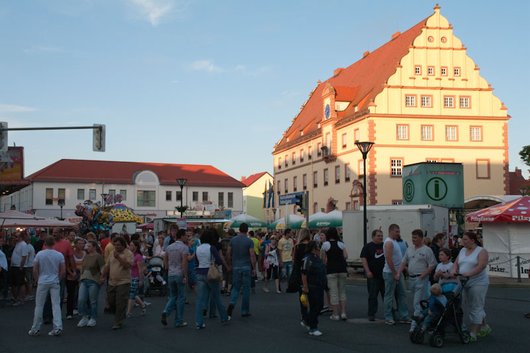In 1403, the citizens began to build their town hall, which was then still called department store. But it was destroyed several times over the centuries. The new building built in 1521 was caught fire in 1535. 1544/45, the town hall was rebuilt in the Renaissance style. Several modifications followed in the course of the centuries, in which, for example, the town hall tower was rebuilt, the staircase was moved from the inside to the outside. Between 21 and 23 April 1945, the town hall was bombed and burned down to the ground. In December 1949, the town hall was rebuilt again.
After the reunification, between 1991 and 1996, more than three million marks flowed into the modernization of the town hall. In the after-millennium flood in August 2002 again necessary redevelopment a civil office was established on the mezzanine floor.
History of the town hall
According to records of urban development, the year 1403, when earl Wilhelm the first took the city under his responsiblitiy was a marked year. At that time the citizens began to build the town hall, which was also called department store in the Middle Ages. But in the same century it must have been destroyed, because 1521 is reported that on 7 September, between 9 and 10 clock, the foundation stone was laid to a new city hall. But even this building was a victim of the flames 14 years later.
And so the citizens of Eilenburg 1544/1545 went on to build a new building on the foundations of the old. In their self-confidence, they built their town hall in the style of the beginning of the Renaissance. Now the city hall became the most important representative building of economic independence and flourishing trade. The town hall, which consisted of cellar, earth, upper and attic, richly structured gables were put on. But also Gothic architecture and design elements were installed. A renaissance-style oriel protruded from the front facing the square on the right. The doors were profiled in a late Gothic Gothic style. Three gables on the long side of the roof with the front to the market square were decorated with volutes and pilasters, which is typical of the Renaissance style.
In the following years, the town hall was changed inside and out. So the town hall tower had to be demolished because of hin ruinous state and a new tower to be built. Two years later, the building was thoroughly renovated and also opened a drinking room for the better company. The windows also received a red sandstone, and the wooden staircase was replaced by a stone one. As early as 1864, the town hall tower was demolished again and provided with a clockwork, rebuilt. The attic has been expediently expanded considering the architectural conditions.
The work was in progress when the 2nd World War broke out. During the artillery fire on Eilenburg the city hall received about 10 direct hits, whose fires could still be extinguished. But on the night of April 21 and 22 and the morning of April 23, 1945, the city hall was so heavily bombed that it was impossible to rescue it. It burned down to the ground. In 1946 work began on the reconstruction of the town hall. The planning provided an extension of about 25 meters in the direction of Rinckartstraße in order to cover the space requirements. It was necessary to include the advice and cooperation of the conservation conservator. Since no satisfactory solution was found, which was architecturally, monument preservation and urban planning appropriate, decided the municipal meeting of 24 September 1946, to rebuild the town hall in its original form. It could be handed over to its purpose on 17 December 1949.
Parts of the town hall and the Ratskeller, were under water during the August flood in 2002. The walls, which are up to one and a half meters thick, were not completely dried out even one year after the flooding disaster, although some of the dryers were running 24 hours a day. Just under a year after the catastrophe, 120 liters of molten water were extracted from the masonry every day.
In the renovation, which was in any case necessary after the flood, a elevator was installed on the mezzanine floor of the town hall, where from 2 February 2004 citizens were be able to submit almost all administrative matters. The financing of an elevator became possible, so that the city hall is now also fully accessible for disabled people.




